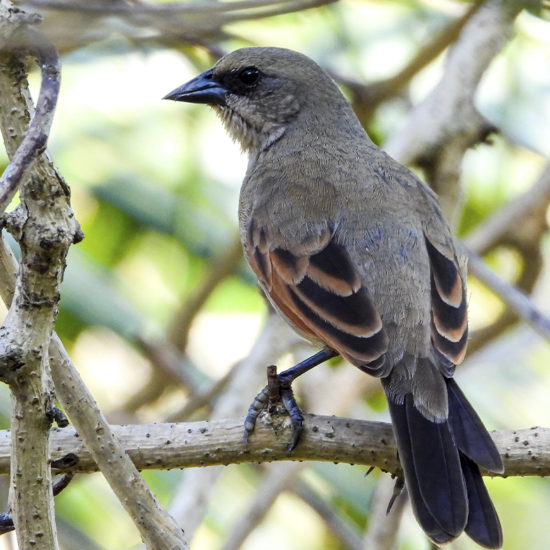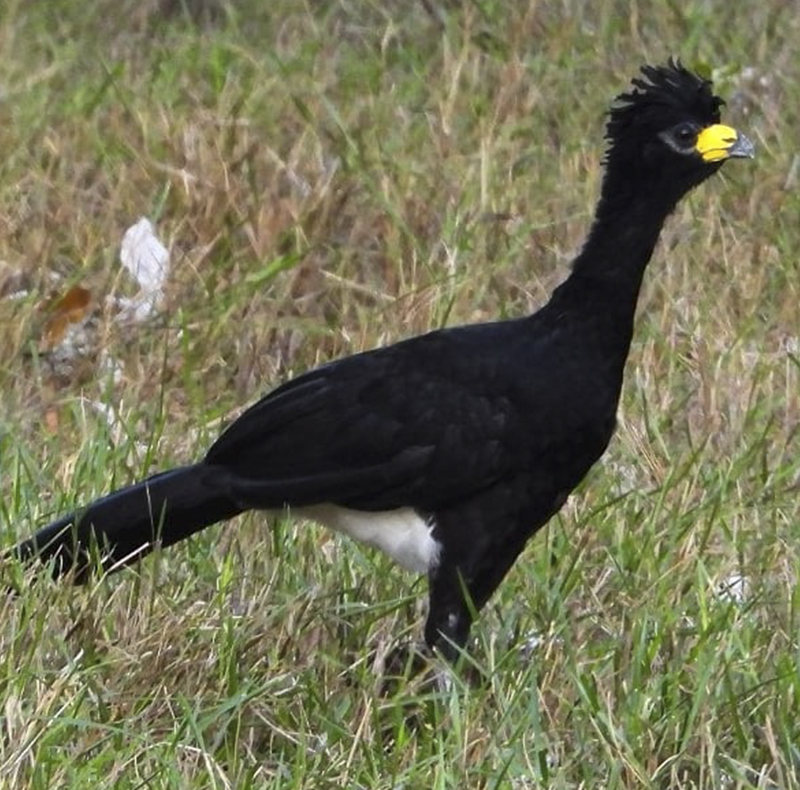Itatiaia – Pantanal and Chapada Dos Guimaraes
Brazil is an immense country with several different ecosystems. This tour is mainly focused on two of the richest habitats in the American continent. For 13 days we will look for a wide variety of mammals, birds, reptiles and amphibians at the Brazilian Pantanal –the world’s largest wetland, and the Cerrado scrubland.
Located in the middle of South America, Pantanal mostly spreads within the Brazilian territory, but part of it penetrates neighboring Bolivia and Paraguay. Pantanal is considered the best and easiest place in South America to get in touch with the most incredible and diverse array of Neotropical wildlife. Wide-open areas facilitate the spotting of animals such as the rare Brazilian Tapir, Marsh Deer, Giant Anteater, Capybara, Black-and-gold Howler-Monkey, Yellow Anaconda, Ocelot, Margay and Jaguar. While this impressive cat occurs over a wide range, the Pantanal is the only place where chances of seeing a Jaguar are not just reasonable, but quite high.
The Cerrado, or Campo Cerrado, with its very characteristic vegetation, corresponds to the arboreal savanna of other tropical continents. It spreads over an area of more than 2 million square kilometers, taking in 23.5 % of Brazil’s territory. This habitat covers most of Brazil’s west-central region, stretching way into Paraguay. Sparsely scattered low trees and bushes with twisted branches, thick grooved bark, and leathery leaves give shape to this distinctive woodland. Reddish-colored termite nests are prominent on the trunks and these are a great attraction to nesting Campo Flicker and Peach-fronted Parakeet, who tunnel into their depths. The bird specialties include Stripe-tailed Yellow-Finch, White-rumped and White-banded tanagers, Coal-crested Finch, Red-legged Seriema, Red-winged Tinamou, Yellow-faced Parrot, the secretive Collared Crescentchest and the endemic Rufous-winged Antshrike.
Key Species
| Agami Heron |
| Amazon Kingfisher |
| Ashy-headed Greenlet |
| Band-tailed Manakin |
| Bat Falcon |
| Bay-chested Warbling-finch |
| Black Jacobin |
| Black-and-Gold Cotinga |
| Black-capped Piprites |
| Black-goggled Tanager |
| Black-throated Saltator |
| Blue Finch |
| Blue Manakin |
| Blue-billed Velvety Black-tyrant |
| Blue-fronted Parrot |
| Brassy-breasted Tanager |
| Brazilian Ruby |
| Brazilian Tanager |
| Buff-bellied Hermit |
| Buff-browed |
| Campo Oriole |
| Chapada Flycatcher |
| Chestnut Eared Aracari |
| Chestnut-bellied Euphonia |
| Chestnut-bellied Guan |
| Coal-crested Finch |
| Collared Crescentchest |
| Cream-coloured Woodpecker |
| Cryptic Antthrush |
| Diademed Tanager |
| Dusky-legged Guan |
| Euler’s Flycatcher |
| Ferruginous Antbird |
| Fiery-capped Manakin |
| Gilt-edged Tanager |
| Golden-chevronned Tanager |
| Grayish Saltator |
| Great Rufous Woodcreeper |
| Greater Rheas |
| Greater Thornbird |
| Green headed Tanager |
| Green Kingfisher |
| Green-and-Rufous Kingfisher |
| Green-billed Toucan |
| Green-crowned Plovercrest |
| Green-headed |
| Greenish Schiffornis |
| Green-olive Tanager |
| Grey-chested Cacholote |
| Guira Cuckoo |
| Helmeted Manakin |
| Horned Sungem |
| Hyacinth Macaw |
| Itatiaia Spinetail |
| Large-headed Flatbill |
| Little Nightjar |
| Long-tailed Antshrike |
| Long-tailed Ground-Dove |
| Magpie |
| Maroon-bellied Parakeet |
| Ochre-rumped Antbird |
| Orange-backed Troupial |
| Orange-winged Parrot |
| Ornate Hawk-Eagle |
| Pale-crested Woodpecker |
| Pallid Spinetail |
| Palm Tanager |
| Pauraque |
| Pavonine Cuckoo |
| Peach-fronted Parakeet |
| Pectoral Sparrow |
| Pheasant Cuckoo |
| Planalto Woodcreeper |
| Purplish Jay |
| Pygmy Kingfisher |
| Pygmy Kingfisher |
| Red Pileated Finches |
| Red-billed Scythebil |
| Red-legged Seriema |
| Red-rumped Warbling-Fincg |
| Red-throated Piping Guans |
| Red-winged Tinamou |
| Ringed Kingfisher |
| Rough-legged Tyrannulet |
| Ruby-crwoned Tanager |
| Rufous Gnateater |
| Rufous-backed Antvireo |
| Rufous-capped Motmot |
| Rufous-crowned Greenlet |
| Rufous-sided Pygmy Tyrant |
| Rufous-tailed Antbird |
| Rufous-tailed Antthrush |
| Rufous-winged Antshrike |
| Russet-crowned Crake |
| Saffron Toucanet |
| Scale-throated Hermit |
| Sepia-capped Flycatcher |
| Serra do Mar Tyrannulet |
| Serra do Mar Tyrant-manakin |
| Sharp-billed Treehunter |
| Sharp-tailed Streamcreeper |
| Shear-tailed Tyrant |
| Shrike-like Tanager |
| Small-billed Tinamou |
| Sooty-fronted Spinetail |
| Southern Antpipit |
| Speckle-breasted Antpitta |
| Spot-breasted Antvireo |
| Spot-tailed Nightjar |
| Star-throated Antwren |
| Streak-capped Antwren |
| Streaked Xenops |
| Sunbittern |
| Sungrebe |
| Surucua Trogon |
| Swallow Tanager |
| Tataupa Tinamou |
| Thick-billed Saltator |
| Toco Toucan |
| Uniform Finch |
| Versicolored Emerald |
| Violet-capped Woodnymph |
| White Woodpecker |
| White-backed Fire-eye |
| White-collared Foliage-gleaner |
| White-rimmed Warbler |
| White-rumped Tanager |
| White-shouldered Fire-eye |
| Whitethroated Hummingbird |
| White-throated Spadebill |
| Yellow-chevroned Parakeet |
| Yellow-legged Thrush |
| Yellow-lored Tody-flycatcher |
| Yellow-tufted Woodpecker |
| Zig-Zag Heron |
Highlights
-

The best place in Latin America to observe the mighty Jaguar, the chance of seeing it is 90% at the indicated time of year.
-

Pantanal is the largest wetland in the world, located in the Mato Grosso region of the Brazilian South and reaching at its extremes as far as Paraguay and Bolivia, with a total extension of 340,500 km².
-

The Pantanal is possibly the richest ecosystem in the world in biodiversity of flora and fauna.
-

More than 3,500 known plant species, including the greatest diversity of aquatic flora concentrated anywhere on the planet, grow in the pantanal.
-

Ornithological diversity is also important, with some 650 species of tropical birds, many of them endemic.
-

The region has been called “an ecological paradise” and “a sanctuary of unparalleled wildlife, and of spectacular beauty”, with species of flora and fauna as dense and diverse as those of the Amazon rainforest. Like the Amazon area, the Greater Pantanal is one of the most densely populated hydro-ecological systems in the world.
- Destination
-
Departure
Aeropuerto Internacional São Paulo-Guarulhos - IATA: GRU, OACI: SBGR
-
Dress Code
This is a fairly standard birding tour with early morning starts and evening finishes to each day. One some days we may take picnic lunches in order to no waste time during the middle of the day or having to leave site. The weather can be unpredictable with rain and sunshine both likely. At higher altitudes it can be chilly. We have an amazing photo opportunity for many species of hummingbirds and other species coming to feeders, we will also be looking for a good number of species that are very rare and seldom seen, but we will be going to areas that hold these sought-after species.
Day 1. São Paulo to Itatiaia National Park
Day 2. Itatiaia National Park
Day 3. Itatiaia National Park
Day 4. Itatiaia National Park to SP and Flight to Cuiaba
Day 5-6. Chapada dos Guimarães.
Day 7. Chapada dos Guimarães to Pantanal.
Day 8. Northern Pantanal, Pouso Alegre. Morning boat trip at Rio Claro
Day 9. Transfer to Porto Jofre. Lunch at Pixaim
Day 10. Pantanal – Porto Jofre and Cuiabá River.
Day 11. Pantanal - Pixaim River.
Day 12. Pixaim River To Piuval
Day 13. Pantanal - Piuval
Day 14. Pantanal To Cuiabá, Flight to Sao Paulo

































